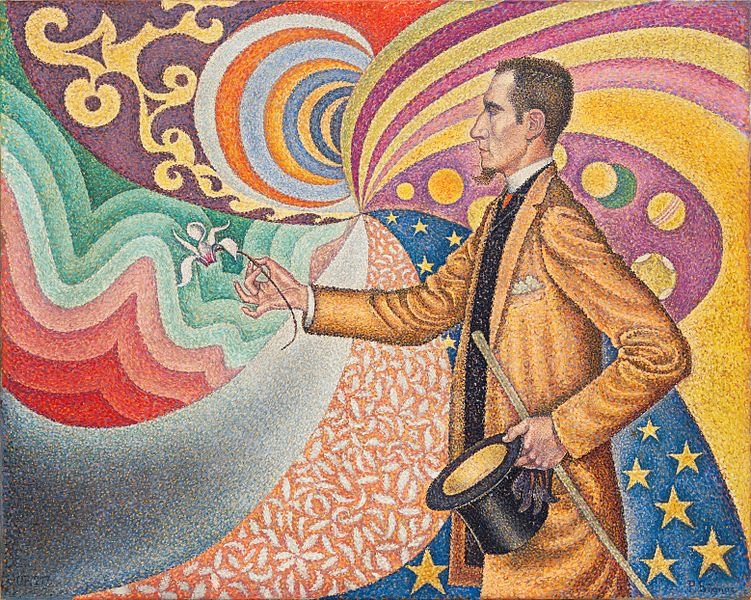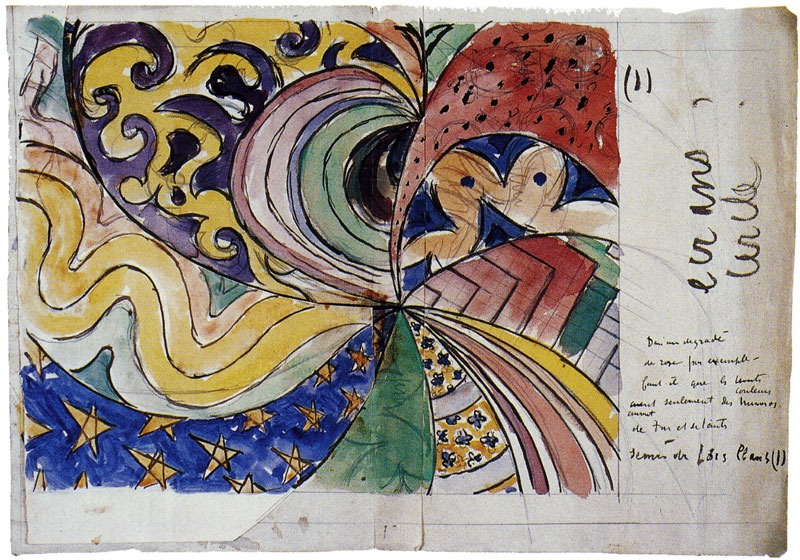NEO-TRADITIONALISM AND NEO-IMPRESSIONISM
Denis does go on to speak about 'a science - do we know it? - which covers these things: Aesthetics, which is becoming precise and which, thanks to the practical researches of Charles Henry, is firmly based on the psychology of the Spencers and the Bains.' Henry had established a 'laboratory for the physiology of sensations' arguing that human reactions to stimuli, including stimuli by works of art, could be subject to mathematical calculation. He understood the whole of reality as an exchange of vibrations whose speed could be measured, a proposition most easily demonstrable in terms of colour. It was Signac and Seurat and their champion, the art critic Félix Fénéon, who were most interested in Henry's theories. Signac had prepared many illustrations for Henry's studies such as his Education on the meaning [sens] of Forms and his Application of new instruments of precision (chromatic circle, aesthetic table and aesthetic triple-decimeter) to archaeology, both published in 1890, the year of Denis' Neo-Traditionalism. (2) In May 1890, just three months before the appearance of the Définition, Fénéon published an article on Signac which could be said to anticipate the famous first proposition, at least in the reference to 'anecdote' and the dissatisfaction with reproducing the fleeting appearances of nature: 'Mr Paul Signac can create exemplary specimens of an art with great decorative possibilities, sacrificing anecdote to the arabesque, identification [nomenclature] to synthesis, the fleeting to the permanent and, in his celebrations and his marvels [les fêtes et les prestiges] he confers on nature, abandoned in the end by its uncertain reality, a true reality.' (3) Fénéon was a contributor to Art et Critique, the journal that published Néo-traditionnisme and we can assume the term 'Néo-traditionnisme' was coined with 'Néo-Impressionnisme' in mind (the term was current - Fénéon had already used it in 1887 (4)).
(2) See eg John Rewald: Post-Impressionism - from Van Gogh to Gauguin, New York, Museum of Modern Art, 1956, p.139
(3) Félix Fénéon: 'Signac', Les Hommes d'aujourd'hui, vol. 8, n° 373, May 1890. Quoted in Richard Thomson and Belinda Thomson: 'Maurice Denis' "Définition du Néo-traditionnisme" and anti-naturalism (1890), Burlington Magazine, Vol 154, No 1309, April 2012, pp.260-267. My very awkward translation from the French.
(4) eg Félix Fénéon: 'Le néo-impressionnisme. IIIe exposition de la Société des Artistes Indépendants', L’Art moderne (Brussels), t. VII, n° 18, 1st May 1887, p. 73-76

Signac: Sur l'émail d'un fond rythmique de mesures et d'angles, de tons et de teintes, Portrait de M. Félix Fénéon en 1890

Signac: Study for "Portrait of Félix Fénéon"
(https://www.pubhist.com/w20530)
Gauguin and the Nabis on the one side ('Nabis' - prophets - was the nickname given to the group by Sérusier. The term 'Neo-traditionalist' never caught on), the Neo-Impressionists on the other were two rival, indeed hostile camps, with the Neo-Impressionists as modern, scientific, rationalist Republicans soon to be identified with anarchist politics and the Nabis religiously inclined and soon, at least in the case of Denis, to become involved with Charles Maurras' monarchist-Catholic movement Action Française. Charles Henry was very much identified with the Neo-Impressionist side. (5)
(5) The antagonism between the two sides, with Fénéon as champion of the Neo-Impressionists and Albert Aurier as champion of the Symbolists, is explored in Michael Marlais: Conservative Echoes in Fin de Siècle Parisian art criticism, Pennsylvania State University Press, 1992.
Though Denis was anxious to maintain good relations where possible. Later in 1890 he wrote to the theatre director, his old schoolfellow from the prestigious Lycée Condorcet, Aurelian Lugné Poë, to say 'Good relations to be added to the old ones: father and son Pissarro. We are on very good terms with Signac.' Who was to write in June 1891, in an unsigned article in the anarchist journal La Révolte, about the 'symbolist impressionists who, in confining themselves to retrograde subjects, fall into old errors and forget that art does better to search out the future, so vast, than to exhume the legends of the past, no matter how golden they may be.' (6)
(6) Denis to Lugné Poë in Richard Thomson and Belinda Thomson: Maurice Denis, p.267. Signac in Marlais: Conservative Echoes, p.100.
Denis evokes Henry again in his essay on Symbolism, when he describes the 'two deformations' which he had worked out 'with the aid of my friend Sérusier.' The first is the deformation of the appearances of the external world (the 'nature' which he tentatively defines in Neo-Traditionalism as 'the sum total of our optical sensations') to convey 'the feeling that nature has inspired within him ... Everything of a lyrical character is permitted him - he must needs practice metaphor like a poet. If this tree seems red to him, he has the right to render it in vermillion. That is "subjective deformation".'
But:
'In order to correct the fantasies of such interpretation, all we had - and I say this with reservations - was "objective deformation", that is, the will to conform the image thus obtained to the technical and aesthetic norms proper to a work of art. We sought those laws both among theoreticians such as Charles Henry and among the works of the old masters: the ancient principles of contrast, balance, unity common to all the arts, necessary most of all to architecture, which thus oblige the artist to "transpose all into beauty".'